You need a place to save your extra change. Whether it is for a night on the town, exotic wood to turn, or for more woodturning tools, you need a coin bank. If you are saving for your turning projects then let’s get busy and turn a coin bank to help you save.
The inspiration for this project came from an article in the Woodturning Magazine, January 2016. Stuart King’s article on turning a cottage-style money box inspired me to think about turning a coin bank. The shape I decided on was a barrel.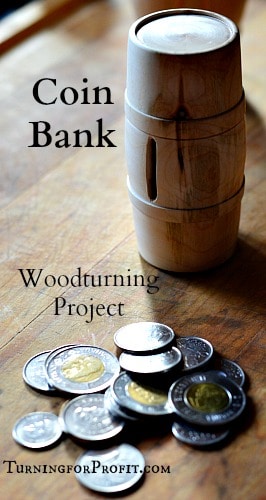
My first attempt is recorded in this post where I talk about learning from your mistakes. Make sure you are alert and paying attention to what you are doing when turning on your lathe.
Coin Bank: Design Considerations
This is a turned box with a coin slot added to make it a coin bank. You want it large enough to hold a fair amount of spare change. The lid should be a tight fit but don’t count on lifting the box by the lid if it is full of coin. My barrel ended up being 4” long and 2” wide.
The coin slot needs to be large enough for your biggest coin. In Canada that is our $2.00 coin. It is 1 1/8” in diameter. You could use a smaller slot if you were only going to put in smaller coins like dimes and pennies. In my project the coin slot just fits between the rings that I turned on the body of the barrel.
The easiest way to turn the barrel is to turn the general shape of the barrel first then add a couple of grooves with a skew chisel to mark out the rings. In my earlier attempt I marked out the barrel rings first then tried to shape the barrel so that the lines would flow under the rings. That was harder to do.
Remember to follow safe practices as you turn and wear appropriate safety equipment. If at any point you are unsure of the turning process suggested stop and figure out a way that is comfortable for you. If you need easier projects check my inventory page and make an appropriate selection.
Process for Turning a Coin Bank
Preparation of blank
Select a blank that will be good for this project. I used a Douglas Maple branch. Mount the blank between centers on your lathe. Turn the blank round and add a tenon on each end. The tenon allows you to hold the blank with your multi-jawed chuck later in the project.
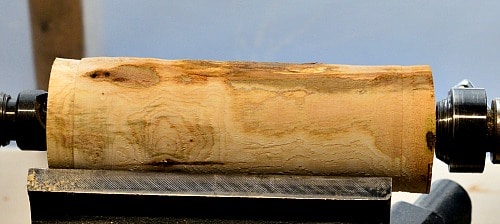
Marking and design choices
With the blank held in your multi-jawed chuck, use a pencil, to mark out the rough dimensions of your project. How big is your cap or lid going to be? In this project I made the cap and the bottom of the barrel the same distance. Where will the rings on the barrel be placed and where are you going to part the bottom from the lid?
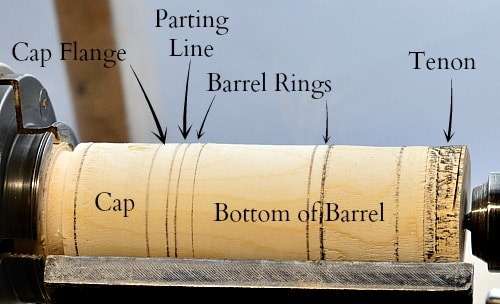
You want to hold the cap in the jaws first. This keeps the number of times you need to mount the wood on the lathe to twice for the project.
Initial Shaping of the barrel
Generally barrels have the same size for their top and bottom. Use a parting tool to cut down to the diameter that you want on your barrel. This barrel has a diameter of 1 5/8” top and bottom.
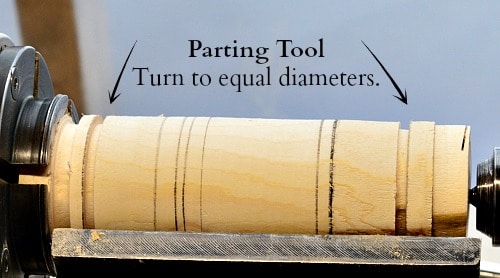
Turning down the bottom of the barrel with a skew chisel I am making a nice curved shape from the mid-point of the barrel to the defined diameter at the bottom.
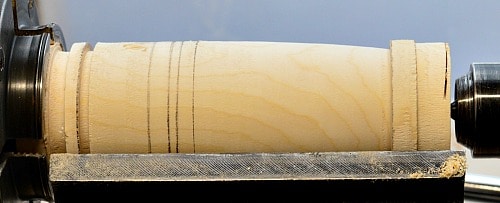
Shape the rest of the bottom of the barrel. I used a narrow parting tool to show where I am going to separate the lid from the bottom of the barrel. I have also used a wider parting tool to shape the size of the flange on the lid.
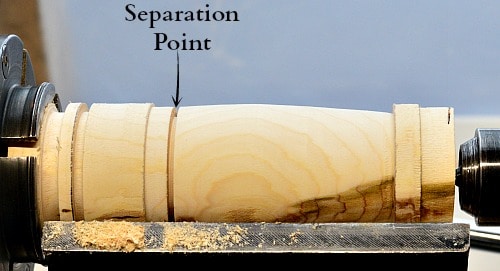
Next you shape the lid of the barrel and determine the diameter of the flange. This is a key part of your turning. You want the flange, and the recess that it goes into, to be parallel with your lathe bed. This will give you a secure lid that won’t fall off too easily.
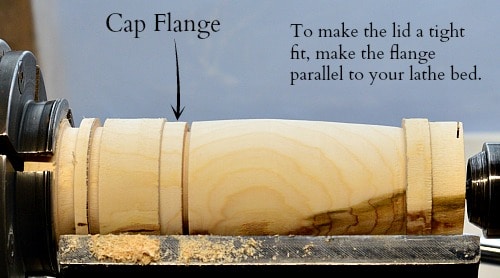
For this project I did not determine a diameter for the flange. I should have. Even if it makes your join between the two parts a bit thick, that is better than not being able to have enough wood on the bottom barrel to slide over the flange. I was close on this one and would have liked to make it thicker on the bottom barrel.
Since you will have to true the bottom of the barrel when you remount it on the chuck, you need a bit more wood to work with. The smaller the diameter of the flange the more room you will have to work with.
So here is the lid shaped and the flange turned down. Shaping the lid is a little tricky as you want to extend the shape of the barrel over the flange. (The top of the bottom of the barrel should be the same diameter as the barrel portion immediately next to the flange on the lid.) Now you can part the bottom from the lid with your narrow parting tool.
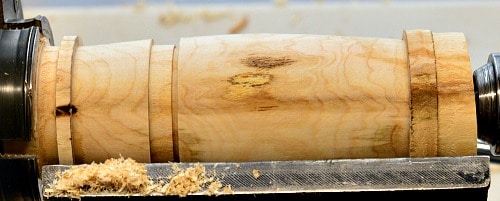
Hollow the lid
Now just the lid is mounted on the lathe. You are ready to hollow out the lid. Make sure the thickness of the flange is enough to support the lid on the box. It would depend on the wood that you are using.
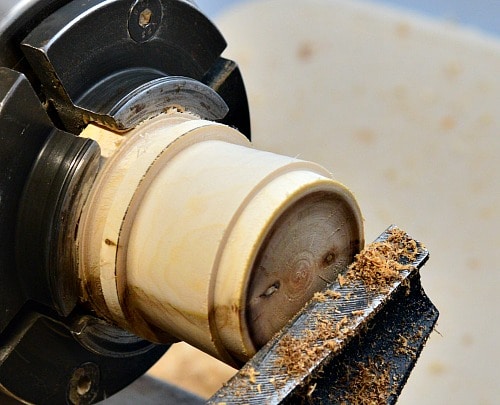
Use a bowl gouge and square scraper to shape the inside of the lid. As the top portion will be end grain don’t try for too thin of a top. At this point sand the inside of the lid.
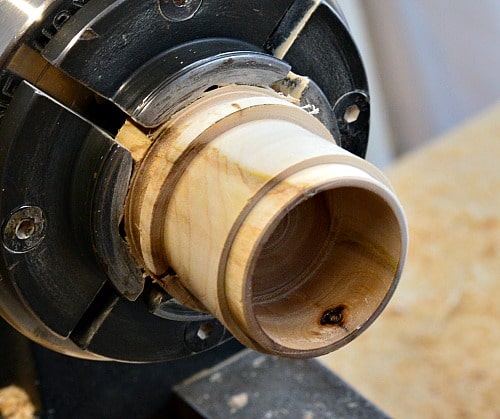
The sanding for this project uses regular sand paper from 220 grit to 800 grit (220, 320, 400, 600, and 800). Remember to wipe with a soft cloth between each grit size of sandpaper.
Don’t sand the outside of the lid. Now you can part the lid off of the lathe.
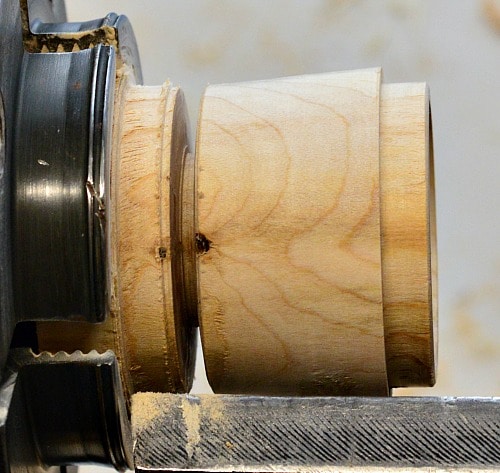
Final shaping on the lathe
Mount the bottom of the barrel in your multi-jawed chuck. Try to get the blank as true as you can. When you turn on the lathe there is likely to be some wiggle apparent on the barrel. So your first step is to true the barrel back to round.
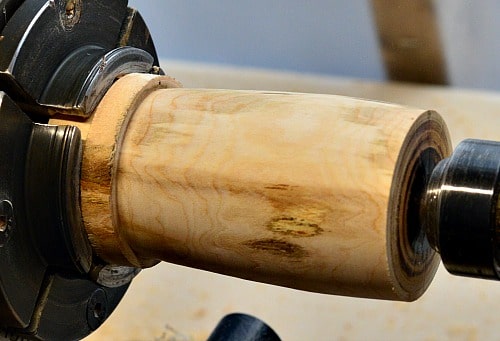
The easiest way to true the blank, with the least amount of wood loss, is to take a pencil and make several lines on your wood. The wood is true when the pencil line goes completely around the blank. As you can see on the image the pencil marks go farther around the blank the closer the line is to the headstock of the lathe. Each time you take off a fine cut you will remove the pencil line. Repeat until your pencil line goes all the way around the wood.
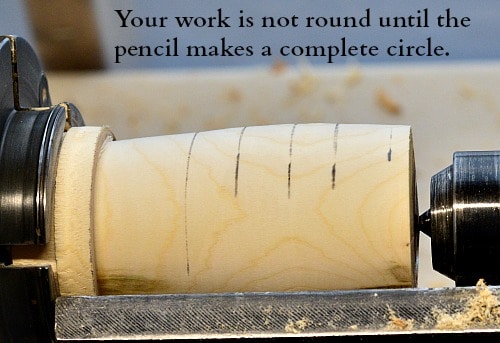
Now that the bottom of the barrel is trued, that is, centered on the lathe, you can turn a recess for the flange from the lid to fit into.
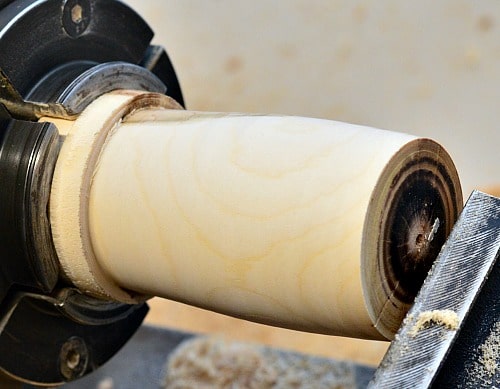
As the flange was cut parallel to the lathe so the recess needs to be parallel to the lathe as well. This was where I turned the wood quite thin. I should have had a smaller diameter on the flange then I would have had more support for the recess on the barrel bottom.
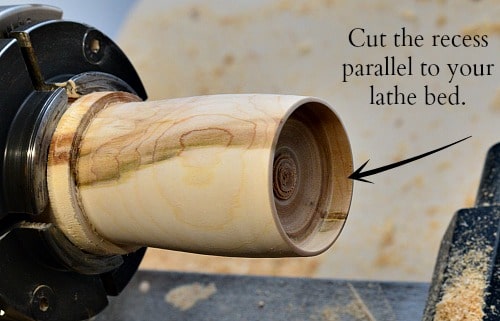
Take your time on this step. Stop the lathe and check to see if the lid fits. Don’t try to fit the lid on while the lathe is turning. You are likely to break your box if you do.
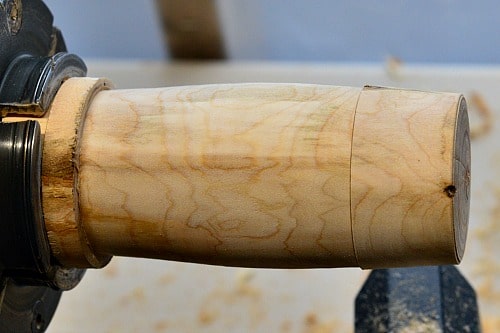
With the lid fitting onto the bottom of the barrel, we can finish shaping the barrel. Bring your tail stock up to keep the lid in place.
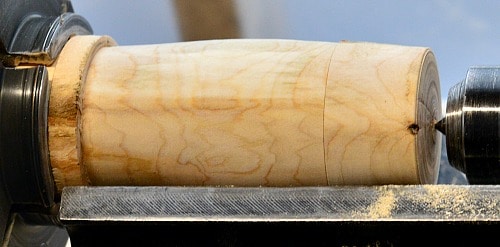
First smooth out the shape you want for the barrel. Second cut small V grooves with a skew chisel to define the rings of the barrel. Third carefully shape the barrel with your skew chisel until it looks like the rings are over the staves of the barrel. Remove the tail stock support and holding the lid with your hand, if necessary, turn the top of the barrel to a shape that you like.
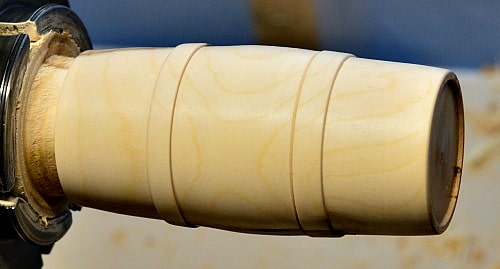
This is the point to sand the outside of your barrel using the same steps as mentioned above.
Hollow the bottom of the barrel
Remove the lid and position your tool rest so you can hollow out the bottom of the barrel. Again your bottom will be comprised of end grain and could break if turned too thin. I left the bottom of the barrel quite thick, over a 1/4″ thick, to give it enough strength.
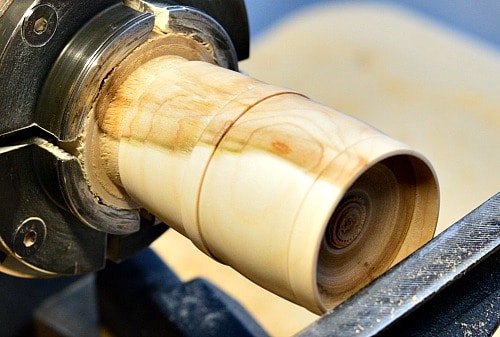
Proceed in layers using a bowl gouge and a scraper to hollow out the bottom of the barrel. Remember the shaping of your barrel as you proceed so you don’t accidentally break through the wall of the barrel as you approach the bottom. Use calipers and check frequently to get a uniform wall thickness.
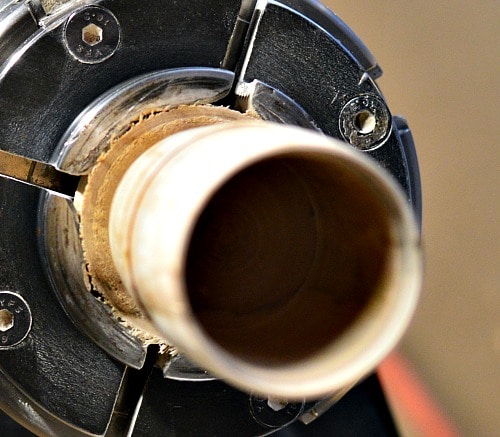
Once you have shaped the inside of the barrel then finish the inside the same way you finished the lid earlier in the project. To keep your fingers safe wrap your sand paper around a dowel and use that to sand the inside of the barrel.
Make the coin slot
Mark the position on your barrel that you want your coin slot to go. Measure your largest coin and mark it out appropriately.
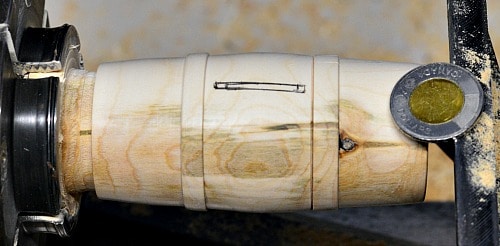
I used a set of small carving gouges to cut out the coin slot. I think next time I will determine the thickness of the coin and use a slightly larger diameter drill bit to drill out the two ends of the slot. You could use other tools that you are comfortable with for this procedure.
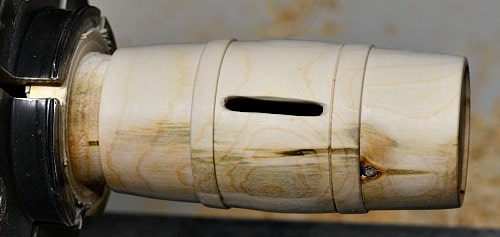
You are now ready to part the bottom of the barrel off of the lathe. Once parted off of the lathe, sand and finish the bottom of your barrel. I did not try to jam chuck the bottom because the wood was too thin. If your wood is thicker you could jam chuck the barrel onto the lathe and turn the bottom of the barrel to match the top.
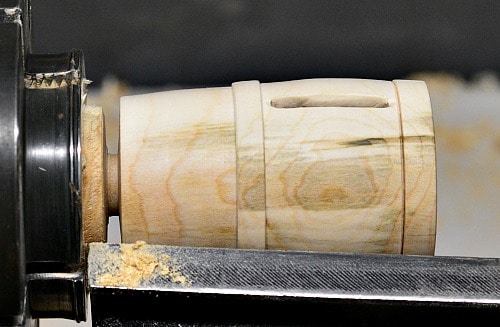
Production options
As with many turning projects if you repeat the process a few times the steps will become more familiar and easier to accomplish. The addition of a coin slot turns a lidded box into a coin bank. There is no reason to turn a barrel; that is the design option I choose. As the process is fairly complicated I would call this an intermediate project.
Preparing multiple blanks and devising a repeatable system for the coin slot will decrease your production time.
Marketing / Business implications
The options for a coin bank are quite varied. These could easily be a high-end product and suitable for gallery sales and the like. Turning boxes should be more expensive than your simple and direct spindle turning. The amount of detail and the type of wood(s) you use also impact the value. As a marketing tip I would put a penny in each coin bank before you sell it.
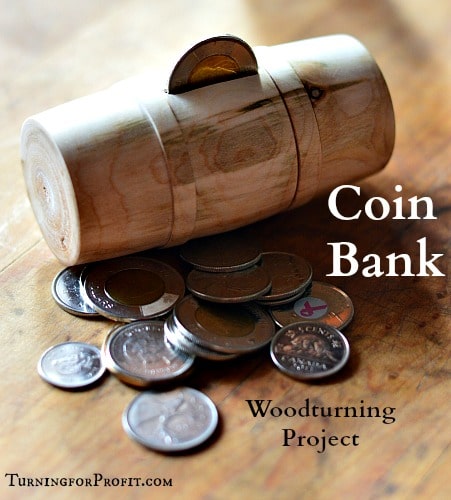
I hope you enjoyed this project as much as I did. Given that it was the second attempt it was very satisfying that it worked out and a suitable barrel coin bank was the result. If you want to turn a box that is not quite as finicky you can try a mushroom box for your garden.
I enjoy preparing these projects and sharing them with you. If you want to receive notice when I post projects and business articles on my website please sign up for my newsletter.
I would love to see what you have turned.





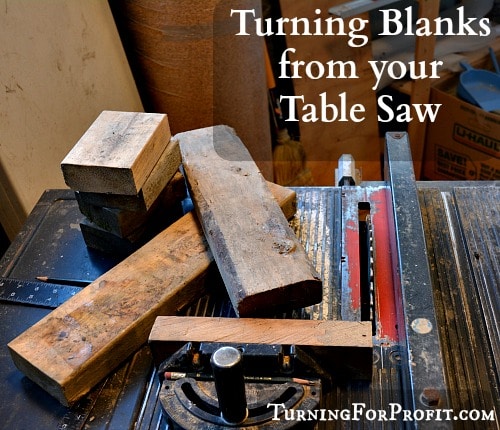
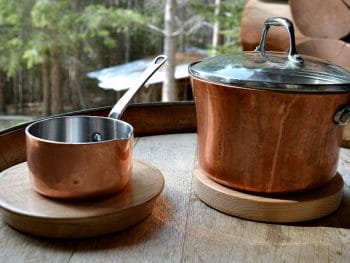
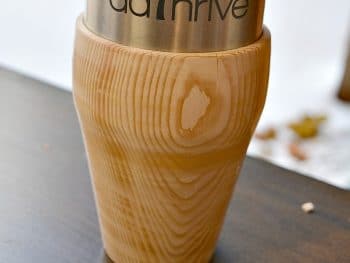
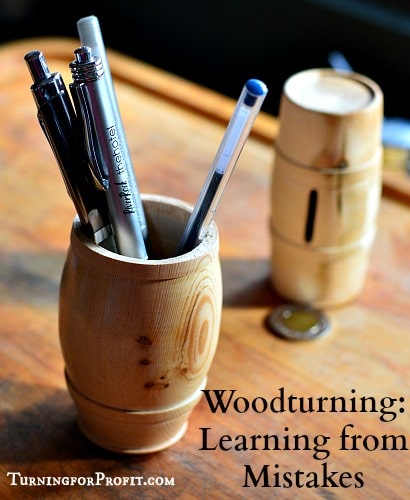
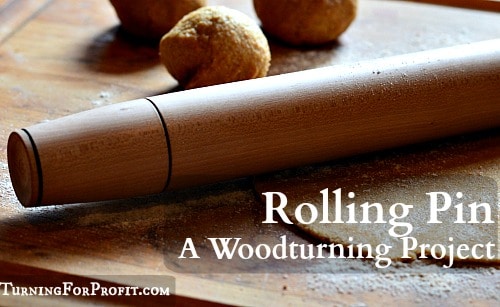
Hi Robin,
Your challenge sounds good but I do not do facebook,
I am however going to send this to a newbie in the world of turning. I think she will learn a lot from you as I have,
Keep up the good work
Roy
Thanks Roy. The challenge you are talking about is the Christmas Planner challenge occurring October – December 2019. Challenges are held in the “Woodturning Entrepreneur Facebook Group“. While the challenges might be over people can still join the group. Thank you for your comment.